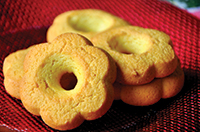
Kamut or khorasan?
February 3, 2012
By
Brandi Cowen
The difference between khorasan wheat and kamut comes down to a trademark.

|
|
| This grain has made its way from ancient Egypt to these pretty Kamut sugar cookies.
|
The difference between khorasan wheat and kamut comes down to a trademark.
Kamut is actually a very old variety of khorasan wheat and a registered trademark owned by Kamut International. The organization was founded by Montana farmer Bob Quinn to protect the genetic purity of the heirloom variety of khorasan wheat.
An oft-repeated story credits kamut’s arrival in North America to a United States airman stationed in Egypt after the Second World War. In 1949, Earl Dedman took a handful of grain from an Egyptian tomb and mailed 36 small kernels home to his parents’ farm in Montana. For several years, the Dedman family tended to a small plot grown from the seeds, but over time their interest in the crop waned and the grain was forgotten. Some 30 years later, another Montana farmer acquired a jar of these ancient kernels. T. Mack Quinn and his son Bob, an agricultural scientist at the University of California Davis, began breeding the seeds and sought to learn more about their heritage.
Father and son eventually traced the grain’s origins back to Egypt’s so-called fertile crescent, an area of very arable land located around the Tigris and Euphrates rivers. Although khorasan wheat was certainly grown in the area for many, many years, it’s still unknown whether it actually originated in the area. Bob Quinn has speculated that invading Greek or Roman armies may have introduced the wheat variety to Egypt thousands of years ago.
Regardless of where it originated from, today kamut is grown across Alberta, Manitoba and Saskatchewan, and several of the Great Plains states. In 2010, Kamut International reported 130 co-operative, organic family farms grew 35,000 acres of kamut across North America.
To preserve the unique traits associated with the variety of khorasan wheat plucked from the Egyptian desert decades ago, Kamut International has established criteria to differentiate the heirloom variety of khorasan wheat from varieties that may have become contaminated with other wheat varieties. In order to be considered kamut, a wheat must:
- Be the ancient variety of khorasan
- Be grown according to certified organic standards
- Have a protein content ranging from 12 to 18 per cent
- Be 99 per cent free from contamination by modern varieties of wheat
- Be 98 per cent free from all signs of disease
- Contain between 400 and 1,000 selenium parts per billion
- Not be used to deceive or mislead consumers as to the percentage of kamut in a product
- Not be mixed with modern wheat in pasta
Because Kamut International holds a trademark on the term “kamut,” any wheat sold under this name must adhere to these criteria. Anyone interested in using the term kamut to describe their wheat must sign a free licensing agreement, promising to respect the guidelines established by Kamut International.
If all of the criteria are not met, the wheat in question is classified as the ancient grain khorasan, rather than its heirloom variety, kamut.
Nutrition notes
Khorasan wheat, including kamut, has large kernels that contain more protein than conventional wheat varieties. Both khorasan and kamut are also higher in vitamins B and E, magnesium, selenium and zinc than many varieties of modern wheat.
Both khorasan and kamut have between two and 2.5 times more resistant starch than durum or soft wheats. Resistant starches aid the digestive system in absorbing nutrients, and have also been shown to improve insulin sensitivity in diabetics, produce satiety, and promote the growth of beneficial, or good, intestinal bacteria while discouraging the growth of harmful or bad bacteria.
A study published in the journal Frontiers of Bioscience last year found that animals fed kamut wheat breads had better responses to oxidative stress than animals fed breads made with modern wheat varieties. The findings suggest that kamut’s antioxidant properties may reduce the risks of chronic illnesses such as heart disease and diabetes. According to the report in Frontiers of Bioscience, making kamut wheat bread using sourdough fermentation techniques can enhance these beneficial properties.
Because khorasan is a variety of wheat, it is not safe for people with gluten allergies or sensitivities. However, research has shown that many people with wheat allergies can eat kamut without experiencing any ill effects. A study by the International Food Allergy Association found that 70 per cent of research participants with severe wheat allergies reported being able to eat foods made from kamut with no or minor reactions. For now though, kamut remains on the Canadian Celiac Association’s list of foods Celiac, allergic and sensitive people should avoid.
If you’re thinking about working with kamut in your bakery, be sure to talk with your suppliers to find out whether the products you’re interested in are properly classed as kamut or khorasan wheat. Both varieties can appeal to consumers seeking healthier products or interested in choosing foods with interesting stories associated with them.
Print this page
Leave a Reply